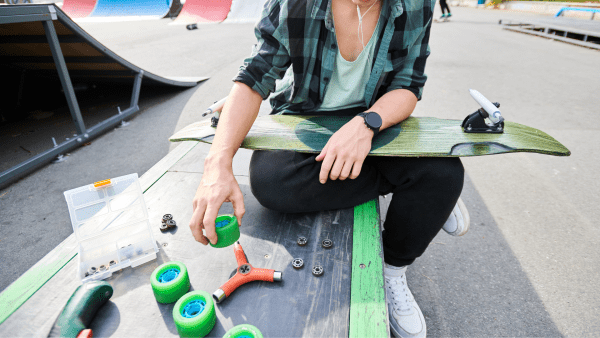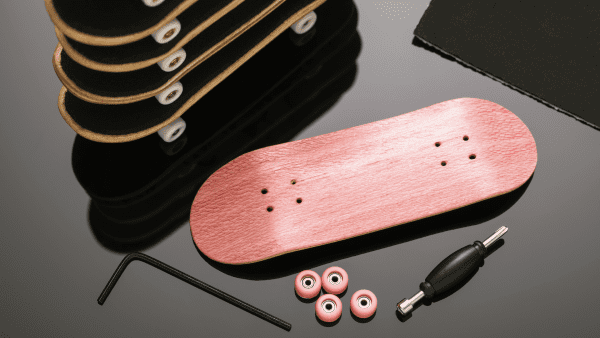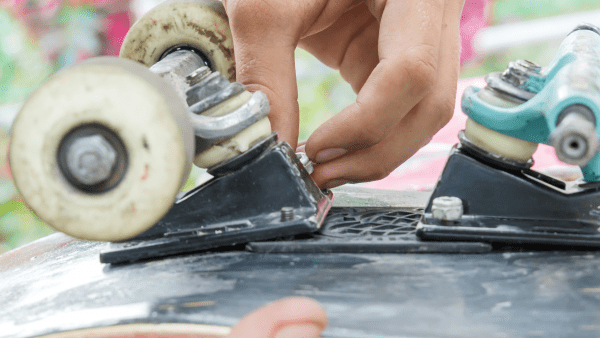We’ve all been there – you’re eager to hit the pavement and enjoy a day of skateboarding, but your trusty board isn’t cooperating. It’s frustrating, we know. This repair article will help you understand your board better, carry out routine skateboard maintenance, diagnose your skateboard’s common problems, repair damages, and even upgrade your skateboard for an enhanced riding experience.

We’ll also cover key safety considerations to ensure you enjoy your ride and do it safely. Whether you’re an experienced skater or just starting out, this guide is for you. With the right knowledge and tools, we can all work together to create a safer and more enjoyable skateboard-riding community.
Let’s roll up our sleeves, grab our skateboards, and get fixing!
Key Takeaways
This article covers skateboards, from understanding their anatomy to performing skateboard maintenance and repair routines, skateboard troubleshooting and diagnosing common problems, and even providing handy restoration tips. We’ve also touched on upgrades and safety considerations for skating. We hope you’ve gained the knowledge and skills to keep your skateboard in top condition and make it last longer.
Skateboard riding is a great hobby for people of all ages and backgrounds, so keep riding and stay safe!
Understanding Your Skate Board
We have to start our understanding of skateboard riding by recognizing the importance of the skateboard’s anatomy.

It’s important to be familiar with each skateboard component, from the skateboard deck to the skateboard trucks and skateboard wheels. The board selection itself is critical to ride comfort and performance. We believe that when it comes to skateboard riding wisdom, it’s always best to share it with fellow skaters. So, let’s take a look into the world of skateboard troubleshooting and skateboard repair, including how to apply grip tape and replace grip tape effectively.
Skateboarding is a part of sports and recreational outdoor activities. There are three main topics to keep in mind: safety, style, and performance.
- Safety is the top priority when it comes to skateboarding. One must always wear skate-protective gear and keep the skateboard in good condition.
- Style is also important, as many skaters customize their skateboards with colorful skate decks and unique designs to express their personalities.
- Performance is a key factor, as the right skateboard can make a huge difference in the smoothness and responsiveness of the ride.
So let’s roll into discussing repairs.
Board Routine Maintenance
Keeping your skateboard in top shape isn’t just about performing tricks smoothly; it’s about ensuring your safety while you’re out there shredding the streets.`
Here are a few skateboard repair tips:
- Clean the grip tape and skate wheels regularly.
- Lubricate the bearings to reduce friction and wear.
- Check and tighten the hardware.
- Replace worn-out parts promptly.
Before we move on, let’s discuss how to diagnose common problems. Additionally, we’ll explore the importance of regularly cleaning and lubricating the components, checking the hardware tightness, and replacing worn-out parts that you can find on time, like trucks, wheels, boards, and other accessories.
Diagnosing And Fixing Common Problems
When you’re flying down the pavement on your skateboard, the last thing you want is an unexpected hiccup due to an undiagnosed issue. Fortunately, this article will help you diagnose common problems like the incidence of wheel bite. This will provide you with the information you need to prevent and restore potential problems and customize your skateboard for a smoother ride.
Let’s transition into the practical world of repairing your beloved skateboard. We hope that with the information we provide, you’ll feel empowered to tackle any problems that come your way.
Making Necessary Skateboard Repair
Let’s dive deeper into the art of skateboard maintenance and restoration. We’ll discuss important processes like tightening or replacing those loose skateboard trucks that are messing with your balance and how to replace a worn-out deck. Remember, our goal here is not just to fix but also to understand our skateboards better, so stick around, and let’s get this skateboard rolling smoothly again.

Tightening Or Replacing Trucks
We understand that truck customization and durability are key to a smooth ride—especially when it comes to shredding the pavement with your skateboard. If you’ve noticed a little wobble, it might be time to tighten or replace those skateboard trucks. To help you out on this journey, we’ve got you covered with a simple guide on how to adjust or replace your skateboard trucks. Additionally, make sure to check for wheel bite and consider replacing your grip tape if needed. For detailed instructions, refer to the guides authored on how to apply grip tape and handle skateboard troubleshooting.
With this information, you should be ready to move on to the next crucial part of your skateboard, the deck.
Replacing The Skate Deck
Replacing your deck can feel like saying goodbye to an old friend, but it’s also an exciting opportunity to breathe new life into your grinding game. Everyone can understand the importance of customizing your new skateboard to make it truly yours. With patience and following our guide, you’ll have a fresh deck in no time. With patience and following our guide, you’ll have a fresh deck with new grip tape in no time. Don’t forget to apply grip tape carefully for the best results.
Now, let’s roll smoothly toward the next phase: upgrading your skateboard for optimum performance!
Working On Upgrades
Now that we’ve covered repair, let’s delve into the exciting world of upgrades.
Choosing the right skate wheel size can transform your ride, and upgrading bearings can significantly improve performance.
This article is here to instruct you through this process, ensuring you make informed decisions that enhance your experience.
Choosing The Right Wheels
Selecting the ideal set of skate wheels for your new skateboard isn’t just about looks – it’s about performance too! It’s important to consider one wheel’s hardness and materials when making your choice. Harder skate wheels are better for speed, while softer skate wheels provide better grip. Materials like urethane ensure durability and smooth rides.
So, now that we’ve got the skate wheels sorted let’s move on to another performance booster – upgrading bearings for an even smoother ride!
Skate wheels come in various hardness levels and materials, such as polyurethane, PVC, and rubber. Bearings are used to reduce friction and improve speed. Urethane, a type of plastic, is highly resistant to wear and tear, making it a great material to use for skate wheels.
By considering skate wheel hardness and materials, skateboarders can ensure they have the perfect set of skate wheels for their skateboard, ultimately leading to a better ride.
Upgrading Bearings
Upgrading your bearings can take it to the next level in performance. To ensure a smoother ride, improved longevity, and greater enjoyment from your skating skills, and skating spirit, it’s essential to upgrade your bearings. We recommend that you consider the quality of the bearing lubrication for the best results.
If you are looking for the ultimate experience, bear in mind that upgrading your bearings is the key to improved performance.
After skateboard bearings, let’s now roll into discussing safety considerations while enjoying this awesome sport.
Safety Considerations When Riding
We can’t stress enough the importance of wearing the right protective gear. It’s not just about looking cool but also ensuring our safety as we ride and perform tricks.
Let’s discuss safe skating practices because understanding them can help prevent injuries and allow us to enjoy skateboard riding for many more years to come.
Importance Of Protective Gear
Skateboarding is a great way to have fun and stay active, but it can also be dangerous if proper safety precautions are not taken. To ensure that you can enjoy skateboarding to the fullest, we have outlined some of the most important protective gear and its benefits. Always make sure to store your skateboard properly to maintain its condition.
Understanding the significance of wearing a helmet is essential. Helmets protect your head, which is the most vulnerable part of your body during a fall. Additionally, regular skateboard maintenance and repair tasks, like checking your skateboard trucks, are vital for safe rides.
Padded clothing also has numerous benefits, shielding you from scrapes and bruises. It is also important to wear elbow and knee pads to prevent joint injuries and wrist guards to safeguard your wrists. Ensuring that your skate deck and skateboard grip tape are in good condition will also improve your safety.
By taking these safety precautions, including examining your bearings and pivot cups, you’re not only protecting yourself from potential injuries but also ensuring that you have the best experience possible.
Safe Skating Practices
Now that we’ve discussed the importance of gearing up, let’s move on to our next topic: safe skating practices.
Skateboard riding safety requires more than just protective gear; it also involves respect for others. The skateboard riding community is built on the foundation of etiquette and courtesy. By following the rules and showing consideration to others, we can create a safe environment and ensure an enjoyable experience for all.
We understand the importance of a skateboard for entertainment, recreation, and sport.
Conclusion
We’ve covered a lot about skateboards, from understanding their anatomy to performing repair routine, diagnosing common problems, and even providing handy repair tips. We’ve also touched on upgrades and safety considerations for skating. We hope you’ve gained the knowledge and skills to keep your skateboard in top condition and make it last longer.
Skateboarding is an incredibly popular hobby for people of all ages and walks of life. We believe in the importance of family, community, and the joys of skateboarding.
To further explore skateboard maintenance and repair, you can read about skateboard tools, hardware techniques, and bearings. You can also look into decks, trucks, and skateboard wheels. With these topics combined, you’ll have a better understanding of how to maintain and repair your skateboard.
Keep riding, and stay safe!
Frequently Asked Questions (FAQs):
How To Fix A Skateboard Deck?
To repair a skateboard deck, consult a skateboard repair expert. Add new grip tape to address common issues like a razor tail. If there’s a hole, use glue and dust the area to reinforce the one point of damage.
How To Repair Old Skateboards?
For an old skateboard, remove dirt using a paper towel, bar soap, and soapy water, especially from pivot cups and other parts. Then, replace any worn-out parts like the bolts and bushings, or apply new skateboard grip tape if the old one has air bubbles.
How Tight Should Skate Wheel Nuts Be On A Skateboard?
Wheel nuts should be tight enough so the wheels spin freely but aren’t too loose. A skateboard maintenance expert would recommend using a screwdriver to adjust the axle and kingpin nut and ensure all the parts are properly attached.
Should I Grease Or Oil My Skateboard Bearings?
While grease lasts longer and is thicker, oil makes bearing maintenance easier and quicker.
What Liquid Is Best For Skateboard Bearings?
Squeeze in a small amount of skateboard bearing lubricant for your skateboard to perform at an optimal level and guarantee your wheels turn smoothly and effectively. You may find a guide on this subject on a skateboard maintenance blog.
Can You Fix A Deck Yourself?
With the proper equipment and a little skateboard troubleshooting, you can repair a skateboard deck yourself and apply grip tape again if needed.
Can You Use Wood Filler On A Skateboard?
For little fixes on a skateboard deck, wood filler works well.
Can You Fix Skateboard Bearings, Wheels And Trucks?
With the right tools and bearing care, you can fix skateboard bearings, skateboard wheels and skateboard trucks yourself. For further assistance, refer to the guides authored for skateboard maintenance and skateboard troubleshooting.
How Do You Seal A Skateboard?
Applying a clear coating of polyurethane to a new skateboard will protect the deck.
How Do You Fix A Warped Skateboard?
Fix a warped skateboard deck by equally distributing weight and exposing the skateboard deck to humidity.
How Do You Prevent Wheel Bite?
Install riser pads to increase the space between each wheel and the deck, reducing the likelihood of wheel bite.
How Can I Repair My Skateboard At Home?
First, determine how well your skateboard is in shape. If the current grip tape is worn out, consider getting a new one to preserve the best traction. Verify that each kingpin and bushings on each truck are not broken or worn. Tightening the kingpin can assist with loose or improperly turning each truck. Furthermore, check that the parts—like the wheels and bearings—match the size of your skateboard. Regular service can stop hard tricks from damaging it.
